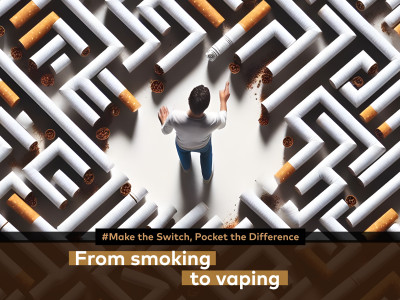“The adverse health effects of passive exposure to conventional cigarette smoke have been extensively studied and are well documented,” writes the Greek/Spanish team. “After 10 years of experience with electronic cigarettes it is known that its active use is associated with immediate adverse health effects.”
The majority of studies the team uses to support this statement come from the use of early types of vaping devices and a limited understanding of the poor wicking/dry burning phenomenon.
The team sat participants (40 non-smokers), one at a time, in a room measuring 35 m3 for 30 minutes with an “an experienced e-cigarette user familiar with a new-generation e-cigarette device”.
Bizarrely, this experienced user was then constrained: “According to manufacturer’s recommendations, the e-cigarette with the 0.5 ohm resistance was set at 22.5 watts (0.5 ohm session), while the e-cigarette with the 1.5 ohm resistance was set at 14.0 watts (1.5 ohm session). Topography for smoking was 4-second puffs with 20-30 second inter-puff intervals using the same e-cigarette device for all sessions.”
Also, probably confirming the inherent bias in the study, the team insisted on using a tobacco-flavoured liquid, the least popular of all juices.
Tzortzi, Teloniatis, Matiampa and Fernández measured the participants for how much nitric oxide was in their breath, otherwise termed the FeNO test. Higher readings indicates likely inflamed airways – and, with ailments, is associated with coughs, wheezing and shortness of breath.
The study states: “The current study found that passive exposure to second-hand aerosol produced by e-cigarette users showed minor alterations in respiratory mechanics and exhaled NO of the exposed participants, while the role of the resistance/power settings was found to be inconclusive.”
Minor changes and inconclusive findings are hardly the kind of things to make a song and dance about, but the team does. They link the change in lung performance to asthma: “The current study found a significant increase in fres after the 1.5 ohm session. It is known that fres decreases with age and increases for both restrictive and obstructive disorders. The obstructive airway pattern, expressed with increased fres, AX, R5 and R20, is evident in asthma where fres, R5 and R20 increase with broncho-provocation and decrease with broncho-dilation.”
The link to asthma is poor given the volume of anecdotal evidence demonstrating the improvement in symptoms when smokers switch to vaping and the lack of evidence to demonstrate a causal association. By their own words, they also admit that what they measured was almost insignificant: “The alteration of fres found in the present study was isolated and did not fall into a specific diagnostic (restrictive or obstructive) pattern. However, it expresses the inhomogeneous airflow distribution33, and hence the increased fres that was found could be interpreted as the footprint of the immediate likely irritative effect that SHA from e-cigarettes exerted on the airways.”
The team states that its study adds “to the growing amount of evidence on the immediate health effects of e-cigarettes.” Only it doesn’t because elsewhere they stated: “The current study examined short-term exposure and so conclusions on the potential long-term effects of second-hand aerosol cannot be made.”
They call for their findings to “be taken into account in global policies regarding the regulation of e-cigarette use in public places.” If anybody comes across some spare findings lying around, please send them to the authors.
Dave Cross
Journalist at POTVDave is a freelance writer; with articles on music, motorbikes, football, pop-science, vaping and tobacco harm reduction in Sounds, Melody Maker, UBG, AWoL, Bike, When Saturday Comes, Vape News Magazine, and syndicated across the Johnston Press group. He was published in an anthology of “Greatest Football Writing”, but still believes this was a mistake. Dave contributes sketches to comedy shows and used to co-host a radio sketch show. He’s worked with numerous vape companies to develop content for their websites.
Join the discussion
Parliament Fears Two
The Department for Environment, Food and Rural Affairs faced questions from a Conservative MP and, oddly, a member of the Department for Environment, Food and Rural Affairs
Harm Reduction For The Rich
The United Kingdom risks becoming a harm reduction country only for the wealthy, according to Michael Landl of the World Vapers’ Alliance
Sacrificing Health For 2p Cut
Tory Government alienates vaping voters with its mission to cut tax by an unaffordable 2p to attract voters by placing a tax on vape products in the forthcoming budget
Scotland Announces Single-Use Vape Action
A ban on the sale and supply of single-use vapes in Scotland is due to come into effect on 1 April 2025, under proposed legislation published today












